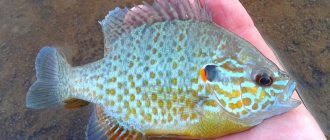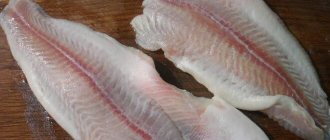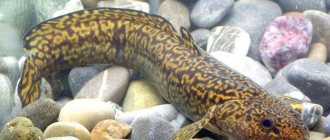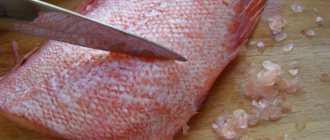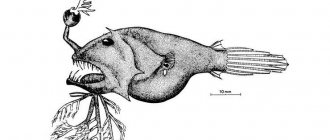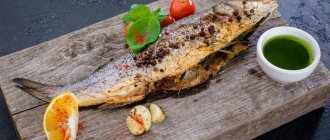a brief description of
This type of fish is considered a delicacy and is liked by both gourmets and lovers of simple food. On store shelves, seafood can be found both fresh and frozen, and fish can also be purchased whole or in fillet form.
The main supplies of the product come from Vietnam.
What does it look like?
The sole resembles a flounder in appearance, as it has almost the same body structure and has eyes shifted to the side. On average, the length of one fish is no more than twenty-five centimeters, but sometimes there are individuals that grow up to 32 - 36 centimeters.
The scales of the fish are brownish-gray in color, which can vary from dark brown to almost beige. On the back of the body, the scales have a lighter tone.
The scales of the sole are very dense and hard to the touch. The scales are densely located and their size is very small, which provides the European salt with reliable protection from predators.
Where does he live?
The lifestyle of the sole is sedentary, so it lives in reservoirs with a sandy bottom, into which it burrows most of the time. In winter, fish can rarely be found far from the depths, but closer to summer, the soleya rises to the surface and lives near the shore, where it is easier for it to get food.
The most common habitats of the sole are salty sea waters near continents with a tropical and subtropical climate. One of these habitats is the Black Sea.
How is sole grown?
Growing sole is a rather difficult task, since it is difficult to create acceptable conditions for breeding this fish. Farms for growing pangasius are much more successful, and they prefer to catch European saltwater with special bottom trawls directly in the fish habitats.
What do fish eat?
The sole feeds on what can be found on the seabed. The basis of its diet is small crustaceans and other arthropods, as well as small mollusks and insect larvae.
Is it possible to eat sole?
European salt is a valuable and tasty delicacy. © https://ydoo.info/product/morskoy-yazyk.html It can be eaten fried, baked, salted, smoked, and boiled. The sole is served with side dishes as an independent dish, and is also added to salads with seafood.

How bony and fatty is this fish?
Solefish cannot be called bony fish, since there are few bones in it. In addition, they are small and very soft, and after heat treatment they are completely difficult to detect.
As for the fat content of fish, sole is considered a dietary product, since its fat content is extremely low.
Taste
The taste of sole depends directly on the method of its preparation and the spices used. In general, the fish has a delicate, original taste and practically melts in your mouth.
Note: If not prepared correctly, sole may taste bitter. Aromatic herbs such as basil, dill and marjoram will help remove bitterness.
Smell
The smell of raw fish is not very strong, marine and pleasant. When prepared, sole has a very appetizing and rich aroma, which is enhanced by the correct selection of spices.
Sole tongue and pangasius - are they the same thing or not?
In stores you can find whole carcasses or fillets. However, gourmets warn against purchasing cut fish: under the guise of a delicacy, unscrupulous sellers can hide cheap pangasius.
Sole tongue and pangasius
Moreover, it can be difficult even for experienced buyers to distinguish a fake. But there are also tricks:
- Ask where the fish “swimmed” from. If from Vietnam, then this is a river pangasius, and saltea comes from the sea or ocean.
- Look at the volume: the thick, fatty fillet belongs to pangasius, and the thin, no more than a centimeter fillet belongs to sole.
- Pay attention to the color: salt is snow-white, and its less noble counterpart is pinkish or grayish.
Types of sole
There are three common types of sole: black, white-necked and arrow-toothed. Each of them includes certain subspecies.
- The black variety of sole includes only one subspecies, which is called bluebark or black. The main feature of the species is not only the dark color of the scales, but also the weight. The average black saltea weighs about 45 kilograms and grows up to one and a half meters in length.
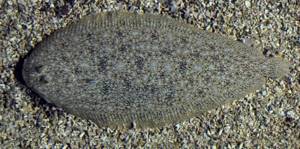
- The smallest representatives of the sole are the arrow-toothed fish species. Their size does not exceed 70 centimeters in length, and their weight is no more than 3 kilograms. The species includes subspecies such as American and Asian sole.
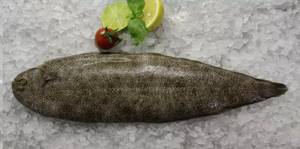
- The white-tipped sole is the largest species of sole. The size of the fish can reach 3 meters in length and weight up to 300 kilograms. This kind of sole is caught using special fishing ships. This species includes such subspecies as the white-tipped and Atlantic sole.
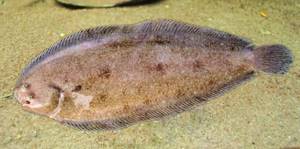
Also, the European sole is distinguished by the side of the eyes, which can be left-sided or right-sided.
The benefits and harms of fish
The benefits of consuming sole for the human body are obvious:
- white tender salt meat contains a lot of protein, easily digestible by the human body;
- tender fish contains many vitamins (A, C, D, PP, group B) and microelements (phosphorus, fluorine, zinc, manganese, iron, calcium), which strengthen the nervous system and bone tissue;
- high content of Omega 3 and Omega 6 fatty acids, helps strengthen the walls of blood vessels of the circulatory system;
- sea fish contains a lot of iodine, which activates the body’s performance and prevents disorders of the thyroid gland;
- recommended for use as a prevention of skin diseases, for people with low acidity to stimulate appetite, to remove toxins and normalize metabolic processes in the human body.
When salt is harmful:
- do not introduce this fish into your diet if you have allergic reactions to seafood;
- if the product shows signs of spoilage or decomposition (not fresh, frozen raw materials);
- when replacing European sole fillet with cheaper pangasius of dubious origin and quality.
Olives and olives - what is the difference, benefit and harm. How to choose correctly.
Read how to make homemade cheese from cottage cheese and milk here.
The recipe for classic kharcho soup with rice is in our article.
How is it different from other fish?
Since the sole belongs to the order Flounder, it has a number of characteristics by which it can be confused with other representatives of this order. For this reason, stores often sell cheaper fish instead of salt. However, there are several features that can be used to distinguish sole from fish of other species.
From flounder
Flounder and sole have a very similar appearance. Their meat is also difficult to distinguish, but it can still be done by the following signs:
- flounder has a wider diamond-shaped body, while soleya is much narrower and shaped like an elongated oval;
- The fins of the flounder are wide, while those of the sole are much smaller;
- on the scales of the flounder you can find many large dark spots; on the sole, if they are found, they are small and barely noticeable;
- Flounder meat always has a white, almost marbled color without streaks, while sole meat can be pinkish or creamy.
As for the taste, the finished flounder is not much different from the European sole, since both fish are marine fish. Except that flounder meat is more watery and soft to the touch, while sole meat is more elastic.
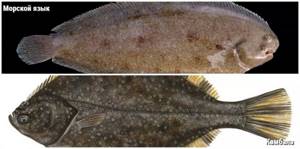
From pangasius
Very often, pangasius is sold instead of sole. Fish can be distinguished by the following characteristics:
- pangasius fillet has a grayish or pinkish color, while sole fillet has a white, almost transparent color;
- the carcass of the sole is usually thin and elastic, while that of the pangasius is more watery and much thicker;
- pangasius has a sharp, unpleasant river smell, while saltea has a more delicate marine aroma;
- the quality of sole meat is much higher according to generally accepted international standards;
- a layer of fat on the fillet signals that this is a pangasius, since the sole does not have fat layers.
If you compare whole, uncut carcasses of pangasius and sole, you will notice that pangasius is much lighter in color and also has dark spots on its scales. The color of the sole is usually darker, and the spots on the carcass are barely noticeable.
As for taste, pangasius meat is tougher and has a less rich, watery taste. Sea sole fillet tastes better.
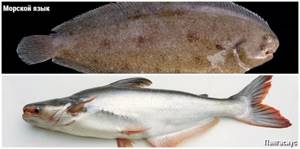
From halibut
The main difference between halibut and sole is that although both fish belong to the order Flounder, their families are different: halibut belongs to the family Flounder, and sole belongs to the Soleaceae. There are also slight differences in appearance:
- the body shape of the halibut is more similar to the usual fish shape, tapering towards the head and tail and widening on the belly, and the shape of the sole is smoother and more streamlined;
- Halibut's scales are usually dark and uniform in color, while sole's scales range in color from dark brown to almost beige.
Fillets of both halibut and sole are available for sale, but it should be borne in mind that sole is sold in thin and not very wide pieces, but halibut can be sold in wide and rather large pieces. It is very difficult to distinguish the meat of these fish by color.
The taste of sole fillet is more tender and pleasant, while in halibut, even after cooking, the meat can give off a sharp marine smell.
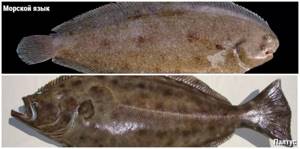
From tilapia
Tilapia is the easiest to distinguish from sole, as it belongs to the perch family of fish. In addition, tilapia is extremely unpretentious to the environment, so it is bred on an industrial scale.
Externally, tilapia resembles a perch, has a silver color, large scales and a sharp dorsal fin. Its eyes are located on both sides of its head, which is the main difference between the fish and the European salt.
The tilapia fillet is also different, which is pink in color with a bright red stripe in the middle, which is not found in sole fillets.
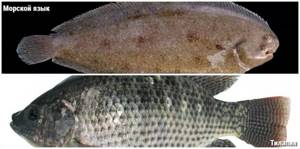
What kind of fish is this and what does it look like?
Another name for the sole is “European Salt”, in everyday life it is salt fish. Belongs to the order Flounder and the Soliaceae family.
Outwardly similar to flounder: flattened, elongated, oval body. Two eyes are located on one side of the body, spends a lot of time lying on the bottom of the ocean or sea.
Small size, length 25–28 cm. The scales are small, hard, gray-brown in color with dark spots. The lower side of the body is lighter than the upper - the belly of the sole is in contact with the ocean floor.
Important! Listed by Greenpeace in 2014, the sole is critically endangered.
Habitat: Pacific and Atlantic oceans, warm waters of subtropical seas. Favorable conditions are shallow water, with a water temperature of 25 °C. It feeds on small crayfish, mollusks, and ocean worms and prefers to hunt in the dark.
How to choose?
When choosing fish in a store, it is important to be able to determine the quality and freshness of the product. To do this, you can use the following recommendations:
- First you need to pay attention to the smell. To do this, slightly raise the gills. If you notice an unpleasant or rotten smell, you should not take the fish. A fresh product should smell like sea or mud.
- The scales of the sole must be wet. Not dry, not sticky, not covered with mucus, but wet. If cracks are visible on the scales or they are dry, this is a sign that the fish has been lying on the counter for quite a long time.
- A bent and dry tail is another signal that the salt is no longer fresh.
- The eyes of the fish should be shiny and the gills should be red. Cloudy pupils and pale gills mean the fish is not fresh.
If you plan to buy not whole fish, but only fillets, you need to follow these recommendations for choosing a product:
- High-quality and fresh sole fillet holds its shape well, so you need to lightly press the surface of the product with your finger. If there is a hole left on it, it means the fillet is not fresh.
- The color of the sole's meat can vary from pale pink to beige. There are also no red spots or stripes on the fillet. This will help distinguish sole fillet from other products that enterprising sellers may offer.
- The surface of the fillet should not be covered with mucus. It should be slightly moist, but not watery or too dry.
- European salt meat has no fatty layers! If they are found on fillets, then this is not the product you need.
To better understand how to choose the right fresh fish, we recommend watching an educational video.
As for frozen sole, when choosing such a product you need to pay attention to the following details:
- Integrity of fins and tail. If they are not broken, it means that the correct freezing and transportation technology was followed. Bruised or chipped fins or tail indicate that the sole was not frozen correctly.
- Carcass integrity. You need to carefully examine the fish so that there are no dents, nicks or suspicious spots on its carcass.
When choosing frozen European sole fillets, you should also pay attention to:
- Ice glaze thickness. According to GOST, the thickness of the glaze should be no more than five percent of the total weight of the carcass. If there is a very thick layer of ice on the fillet, it means that the freezing rules were not followed and you will overpay for water.
- The ice on the fillet should be clear and smooth. The rough and muddy surface, reminiscent of snowy mountain peaks, indicates that the fish was frozen more than once.
We recommend watching a useful video about choosing frozen fish and fillets.
Cooking features, recipes
There are many recipes using fish.
Here is a good site with photo recipes for fish dishes. This fish can be combined with a variety of side dishes and sauces, so you can safely experiment with it. In Italy it is customary to cook it with white wine, the Spaniards prefer fried salt with hot sauce, and in English cuisine this product is consumed with french fries. Beef: when and for what reason did cow meat come to be called that?
But there are many more ways to prepare European salt, and experienced housewives often come up with new options. Very often when cooking, they focus on the size of the carcass, for example: 1. It is convenient to bake small fish whole; 2.Medium carcasses are suitable for steaming; 3. Large carcasses can be handled in different ways: fry, boil, bake in foil.
To make the dish tasty and healthy, you need to choose the right fish. Since it is difficult to distinguish soleya from pangasius in the form of fillets, it is recommended to buy this product in the form of whole carcasses.
Solea europaea is a unique product. When its quality is high and used correctly, it brings enormous benefits to the human body. But unscrupulous manufacturers often offer it instead, and a low-quality replacement, dangerous due to the toxic microelements it contains - pangasius. Therefore, buyers should be careful when choosing a product.
How to store?
To prevent purchased fish from spoiling, it is important to know how to store it correctly.
Fresh
Fresh sole must be stored in the refrigerator. At the same time, if the fish has not yet been gutted, you should remove its entrails before sending it to the refrigerator compartment in order to extend its shelf life. Next, you need to rinse the salt and wipe it with a paper towel, put it in a wide container, cover with cling film and put it in the refrigerator. In this state, fish can be stored for no more than forty-eight hours, after which it must be cooked, otherwise it will spoil.
The freezer will help increase shelf life. Once frozen, sole can be stored for three to four months.
Defrosting and freezing fish again is prohibited, as it will lose its taste.
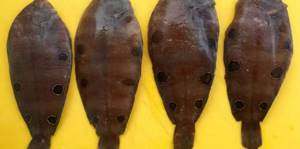
Smoked
Cold-smoked seafood should be wrapped in baking paper and stored in the refrigerator for no more than nine days. This fish can be stored in the freezer for three months.
Hot smoked European salt can be stored for no more than a week in the refrigerator and no more than three months in the freezer.
If the fish has already been cut into pieces, it can be stored in the refrigerator for no more than three days!
Salted and dried
Well-salted and dried sole can be stored for about nine months, but it must be wrapped in parchment and kept in a dry and well-ventilated place.
As for lightly salted fish, its shelf life varies from three to twenty days, depending on the amount of salt. It is also advisable to store salted fish on the bottom shelf of the refrigerator in brine.
Dried sole can be stored from three days to two weeks.
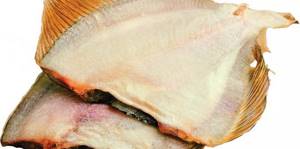
Composition and taste of sole fish, photo
Before buying and using this product, you need to find out what benefits and harms characterize it.
According to its chemical composition, salt is rich in valuable microelements and vitamins. It contains:
- potassium
- fluorine
- phosphorus
- iron
- iodine
- vitamins of groups A, B, C, D, E and PP
In addition to valuable components that benefit health, the taste of the product after its preparation is also very important. Solei meat is moderately fatty and nutritious, and tastes similar to flounder meat, but more tender. Many people prefer this fish due to the small number of bones in it.
Important! At the same time, it is a low-calorie product. This makes it indispensable for people seeking to lose weight. 100 grams of product contains only 80-100 kcal, there are no carbohydrates and very little fat. But at the same time, salt is a source of protein that is easily absorbed by the body.
How to clean and cut?
Cleaning sole should begin with thoroughly washing the fish under running water. You need to wash off all the dirt and mucus, and then dry the salt with paper towels to make it easier to cut it up.
The procedure for cleaning and cutting a sole carcass is as follows:
- The first step is to cut off the head of the fish. To do this, use a sharp knife to pry the gills from above, cut them, moving towards the bottom of the fish, and then cut off the head.
- After this, you need to pry the edge of the skin near the head with a knife and pull it down towards the tail.
- Do the same on the other side of the sole carcass.
- Then, using scissors, cut off the lower fin and use a knife to remove the entrails from the fish.
- Rinse the purified salt again outside and inside.
After this, the whole fish carcass will be ready for further cooking. It can be baked or fried whole. To better understand how to clean sole, we recommend watching the instructional video.
Filleting the sole of the sole is as easy as shelling pears. You need to cut the cleaned carcass in half and carefully remove the backbone, then rinse the fish halves.
How to fry sole in breadcrumbs
In principle, salt can be fried without breading at all, but the dish will turn out tastier with breadcrumbs.
We take:
- Fillet – 400 gr.
- Eggs – 3 pcs.
- Breadcrumbs - 3 spoons.
- Pepper, dry rosemary, salt, oil.
Preparation:
- Divide the washed and dried fillet into portions. Rub with seasonings and salt.
- Break the eggs into a bowl and scramble them with a fork. Place breadcrumbs on another plate.
- Dip the workpieces first into eggs, then transfer to breadcrumbs and roll thoroughly.
- Cook in oil in a frying pan on both sides until nicely browned.
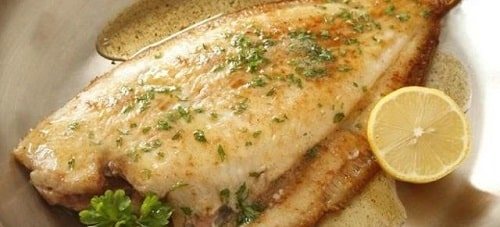
Cooking methods
Sole is a delicious delicacy that can be prepared in many different ways.
How to bake in the oven?
To bake sole in the oven, you first need to clean it and fillet it. To do this, you can use the recommendations above.
This is followed by:
- Rub the cleaned European salt fillet with spices and seasonings on all sides, sprinkle with salt to taste, sprinkle with vegetable oil and leave on the plate for fifteen minutes so that the meat is thoroughly soaked.
- Preheat the oven to 200 degrees Celsius. If your oven has a fan function, you should turn it on.
- Line a baking tray with baking paper or foil, place the prepared sole on it and place in the oven. Note: to keep the fish juicy, you can sprinkle grated cheese on top.
- Bake for at least ten minutes. The average cooking time for sole in the oven is from 10 to 20 minutes, depending on the size of the fish and the power of the kitchen gadget.
The finished dish can be served with a side dish and white wine.
How to fry in a frying pan?
Frying sole in a frying pan is easy. To do this, you need to cut the fillet into portions, heat a frying pan with a smooth bottom over high heat, after pouring vegetable oil into it. When the surface is hot, you can place pieces of salt on it.
You need to fry the fish for about two minutes on each side, and the flame must be slightly reduced. It is better to turn over pieces of sole using two forks so as not to damage the integrity of the fish.
When the surface of the fillet is covered with a golden crust, you can add salt, spices, as well as onions, carrots or cheese to the pan if desired. All this should be simmered for another ten to fifteen minutes, after which the dish should be allowed to brew under a closed lid - and it can be served.
How to put it out?
It is better to stew European salt with vegetables and spicy spices.
To get a delicious dish, you need to follow these instructions:
- In a deep bowl, mix all the spices that will be used when preparing the dish. It is better to take chopped onions and garlic, cumin, paprika and coriander. You can also add salt and other spices as desired. Fresh herbs, vegetable oil and lemon juice should also be sent there.
- Peel and rinse the sole, then dry with paper towels. Then cut the fish into portions and rub thoroughly with the resulting spice mixture.
- Leave the fish rubbed with spices in a cool place for half an hour, and in the meantime heat vegetable oil in a deep frying pan or saucepan and fry the vegetables with which the fish will be stewed.
- Move the fried vegetables to the side and place the fish in a saucepan, then cover it with vegetables and cover the pan with a lid. It takes about fifteen minutes to simmer the dish in this form.
The finished stewed sole should be served with a side dish.
Harm and contraindications
1. To ensure that the salt does not cause harm, it is worth monitoring the cooking process at all stages. It is necessary to abandon various synthetic additives and flavor enhancers.
2. You also need to learn how to properly cut fish. Unscrupulous producers who grow a lot of fish accelerate the growth of sole. Thus, it will do more harm to the stomach and liver than good.
3. It is important to check the expiration date of the product. Fresh product usually does not pose any danger.
4. The product is harmful for people who are allergic to sea fish. You should not include seafood in the menu for children who are under three years old.
5. Limit use during pregnancy and lactation.
6. If you eat sole in large quantities, then unpleasant sensations arise in the gastrointestinal tract.
How to cook?
You can cook sole in a saucepan quite quickly. How long should you cook this fish? The cooking time for European salt does not exceed half an hour.
To cook sole, you need to peel it and cut it into portions if desired. Fill a saucepan with water, put it on the fire and bring it to a boil, then add salt and add the salt there. It should be cooked for 10 minutes to half an hour, depending on the size of the fish.
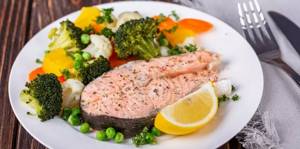
How to steam?
You can steam sole of the sole using a double boiler or a regular pan. The fish should be cleaned and rinsed, dried with paper towels and rubbed with salt (and spices if desired), then placed in a steamer.
It is advisable to line the bottom of the container in which the tongue will be cooked with onion rings to make the fish juicier. Then turn on the steamer and steam the sole for 20 minutes, after which you can serve the dish.
How to cook in a slow cooker?
Cooking sole in a slow cooker is as follows:
- Wash the fish and cut into small pieces, place in a deep container and pour in high-fat sour cream.
- While the sole is marinating, peel other vegetables that will be cooked along with the fish. To do this, peel and chop the carrots, onions and, if desired, potatoes, and then put it all in the multicooker bowl.
- Place the fish in sour cream on top of the vegetables, add a little water, close the lid and turn on the multicooker in the “Stew” mode.
- Cooking time for sole with vegetables is one hour. When serving, it is recommended to sprinkle the dish with fresh herbs.
How to cook in the microwave?
You can cook sole in the microwave either whole or in pieces. To do this, prepare the fish (clean and rinse), then rub with spices and place in a glass container with thick walls.
There is no need to salt the sole before cooking, since in this case, when cooking the fish in the microwave, all the moisture will evaporate from the product, and the dish will turn out too dry.
Cover the container with a lid with a hole to release steam, set the microwave to maximum power and press the “Start” button. The fish will cook from 5 to 15 minutes, depending on the power of the kitchen gadget.
The sole will be ready when its meat begins to flake.
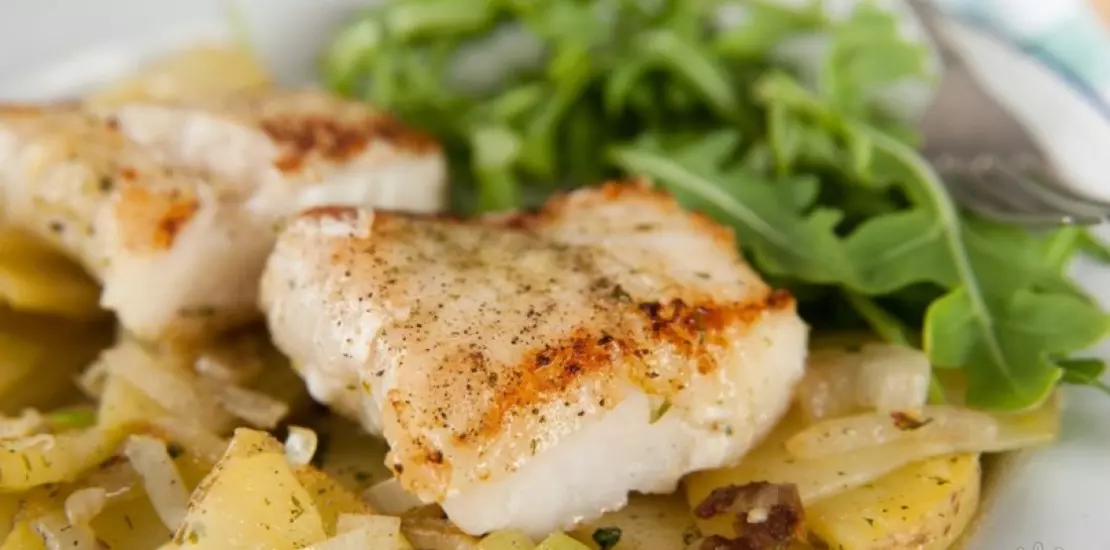
How to grill?
The sole can be grilled either whole or as a shish kebab. The cooking process is as follows:
- Prepare the fish by discarding the skin and entrails with bones, then, if desired, cut the fillet into pieces for kebabs.
- Pour black pepper into a deep container, add lemon juice, your favorite spices for fish, some fresh herbs and soy sauce. Mix everything well, dip the sole into the resulting mixture and leave it to infuse in the refrigerator for half an hour.
- Preheat the grill, then place the fish on the grill (or skewer) and cook until the surface is golden brown.
It is advisable to serve this type of sole with side dishes of vegetables, which can also be grilled.
Benefits for weight loss
In weight loss diets you can often find salted meat. Due to its reduced calorie content, it is ideal for a balanced diet. There are a lot of recipes for cooking - baking in the oven, frying in a pan or grill, in a slow cooker or steaming.
Do you include pangasius in your diet?
- Yes 36%, 24 votes
24 votes 36%24 votes - 36% of all votes
- No 33%, 22 votes
22 votes 33%
22 votes - 33% of all votes
- Sometimes 31%, 21 votes
21 votes 31%
21 votes - 31% of all votes
- I don't eat fish 0%, 0 votes
0 votes
0 votes - 0% of all votes
Total votes: 67
16.09.2019
×
You or from your IP have already voted.
Experts call steamed salt the best dish for weight loss. This recipe will help you prepare it correctly.
Ingredients
Servings: –+1
- Sea sole fillet 500 gr
- Onions 1 piece
- Bay leaf 3-4 pcs
- Salt ½ tsp
- Ground black pepper - to taste
- Greens and lemon slices for serving
Steps
40 min.Print
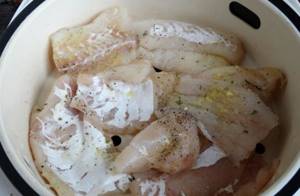
Rinse the fillet with cold water, cut into pieces, add salt and pepper and place in a steamer on top of the onion cut into rings.
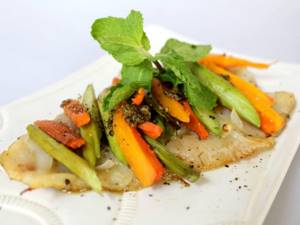
Add laurel. Cook for 20 minutes. Serve hot, garnished with lemon and herbs.
Bon appetit!
What side dishes should I serve with?
You need to select a side dish for serving sole based on your own preferences and culinary capabilities. However, there is a list of dishes that go best with this fish.
Among them:
- potatoes (baked, stewed, mashed);
- rice;
- baked vegetables (tomatoes, carrots, peppers, onions);
- fresh vegetable salads;
- asparagus;
- Chinese cabbage;
- green pea;
- olives;
- zucchini.
Greens are also combined with sole, especially basil, dill and parsley. They can be added to side dishes or sprinkled with herbs on the fish dish itself.

How to cook
Sole tongue is often fried. With this method of cooking, a golden, appetizing crust appears on the meat.
If you close the lid during frying, you will get a very juicy fish. It harmonizes perfectly with sauces based on butter and juices.
There is quite an impressive list of dishes that can be prepared from the meat of this fish. These are both everyday and holiday options. The fish can be cooked whole or cut into portions.
Cooks prepare both simple dishes and complex gourmet masterpieces. It is best to prepare the product based on its size. Baked fish is considered the healthiest.
Italians soak it in dry white wine. The Spaniards serve sole with tomato sauce. In England they like to eat it with French fries.
Note to housewives:
Sea sole - 11 most delicious recipes
This is interesting
Greenpeace has included the sea lion in the Red Book. It also includes fish that are sold in large quantities in most developed countries. The fact is that with unregulated fishing there is a high risk that the halibut will be completely destroyed.
In order to maintain the population of saltfish, people began to grow soles using aquaculture. Their cultivation began at the beginning of the last century, when the Frenchman Paul Louis Marie Fabre-Domergue organized a penned fish farm. The sole was farmed for several years until the farm was devastated by the actions taking place in the First World War.
In the second half of the last century, soleya appeared on farms in Norway, the USA, Denmark and Great Britain. Currently, only 2 types of domesticated halibut are bred, which are characterized by rapid growth and weight gain. This is the European sole and also the Senegalese sole.
Solea is widely used in the food industry due to its tender white and very tasty meat. Catching halibut is a real success for an angler. The value also determines the rather high cost of the Philemorian language, which is sold in stores in numerous countries.

